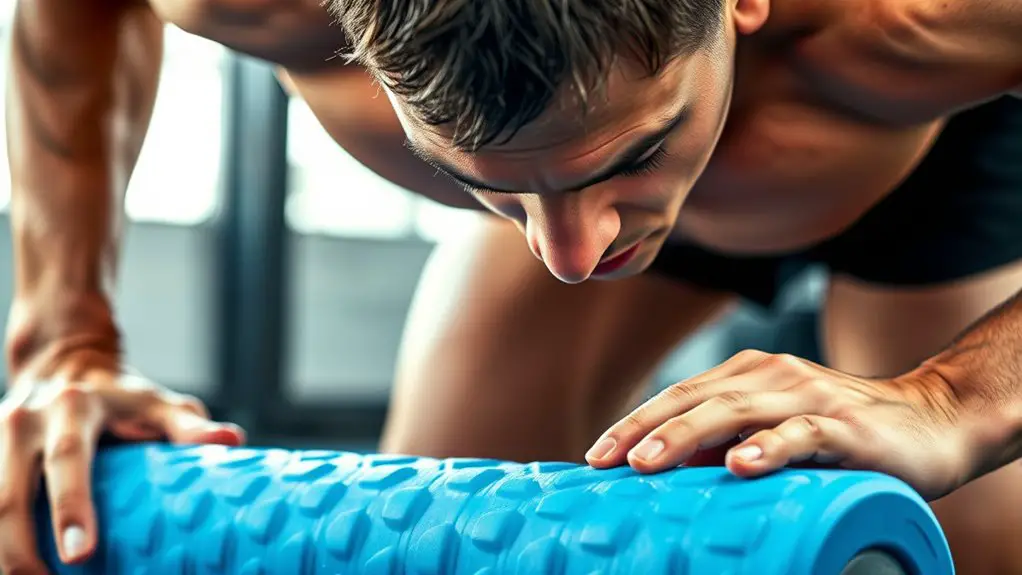Foam rolling speeds up muscle recovery by promoting myofascial release and relieving tightness in muscles and fascia. It increases blood circulation, delivering essential nutrients and reducing soreness after intense workouts. By focusing on sore spots and gently working those areas, you can enhance flexibility and improve overall performance. Incorporating foam rolling into your routine is a simple yet effective way to support your recovery. There's plenty more to discover about maximizing your recovery and performance.
Understanding Muscle Soreness and Recovery
Muscle soreness can feel like a heavy weight after an intense workout, but it's a natural part of your body's recovery process. When you push your limits, tiny tears form in your muscle fibers. This might hurt, but it's your body's way of signaling growth and adaptation. Embracing this discomfort can lead to greater strength and endurance over time.
You might notice soreness peaking 24 to 72 hours post-exercise, known as delayed onset muscle soreness (DOMS). While it can limit your movements, it's crucial to listen to your body. Rest and gentle activity, like stretching or walking, can aid recovery. Remember, your journey to freedom in fitness includes periods of discomfort, but these moments are stepping stones toward your goals. By understanding and accepting soreness, you empower yourself to push through, redefine your limits, and emerge stronger and more resilient than ever. Additionally, incorporating proper nutrition strategies, such as protein from lean sources, can significantly enhance muscle repair during recovery.
The Science Behind Foam Rolling
When you foam roll, you're engaging in a technique that promotes myofascial release, helping to relieve tightness in your muscles and fascia. This process also boosts blood circulation, delivering essential nutrients to your tissues. Incorporating foam rolling into your routine can enhance muscle recovery and improve your overall performance. Understanding these mechanisms can enhance your recovery strategy and improve your overall performance.
Myofascial Release Mechanism
Although foam rolling might seem like a simple technique, its effectiveness lies in the science of myofascial release. This process helps release tension in the fascia, the connective tissue surrounding your muscles. When you roll over tight areas, you're applying pressure that can break down adhesions and improve elasticity.
| What Happens | Benefits |
|---|---|
| Tension Release | Reduced Muscle Soreness |
| Increased Flexibility | Enhanced Range of Motion |
| Pain Relief | Improved Recovery Time |
| Tissue Hydration | Greater Muscle Performance |
| Stress Reduction | Overall Well-being |
Improved Blood Circulation
Foam rolling not only aids in myofascial release but also greatly enhances blood circulation. When you roll over your muscles, you're applying pressure that helps to dilate blood vessels, allowing more oxygen and nutrients to flow to your tissues. This increased circulation accelerates the recovery process, flushing out toxins and reducing muscle soreness. You'll feel more energized and ready to tackle your next workout. Plus, better blood flow can lead to improved flexibility and range of motion, giving you the freedom to move more fluidly. So, if you want to enhance your performance and recovery, grab that foam roller and roll away. Your muscles will thank you for the boost they need to thrive.
How Foam Rolling Relieves Muscle Tension
Foam rolling can be a game-changer when it comes to relieving muscle tension. By targeting trigger points, it helps release tight spots, improves blood circulation, and enhances muscle flexibility. You'll find that incorporating foam rolling into your routine can lead to a more relaxed and functional body.
Release Trigger Points
When you apply pressure to specific areas of your muscles, often referred to as trigger points, it can considerably relieve tension and soreness. Foam rolling helps release these tight spots, giving you the freedom to move better and feel lighter. Here's how it works:
- Direct Pressure: Rolling over a trigger point helps break up tightness and knots.
- Pain Relief: By targeting these areas, you can reduce discomfort and improve your overall well-being.
- Increased Flexibility: Releasing trigger points can enhance your range of motion, making activities easier.
- Faster Recovery: Addressing muscle tension speeds up your recovery, allowing you to get back to what you love sooner.
Improve Blood Circulation
As you roll out your muscles, you not only alleviate tightness but also boost blood circulation throughout your body. Increased blood flow means more oxygen and nutrients reach your muscles, helping them recover faster and feel revitalized.
| Benefit | Description |
|---|---|
| Enhanced Recovery | Quicker healing of muscle fibers |
| Reduced Fatigue | Less soreness post-workout |
| Improved Performance | Better overall function |
| Relaxation | Decreased tension and stress |
Enhance Muscle Flexibility
To enhance muscle flexibility, incorporating foam rolling into your routine can be a game changer. By targeting tight areas, foam rolling helps relieve muscle tension, allowing you to move freely and comfortably. Here's how it works:
- Releases knots: Foam rolling breaks up muscle adhesions, promoting a smoother glide during movement.
- Increases range of motion: Regular use helps lengthen muscles, boosting flexibility and performance.
- Improves circulation: Better blood flow aids nutrient delivery, essential for muscle recovery.
- Reduces soreness: Less tension means quicker recovery post-workout, so you can stay active without pain.
Embrace foam rolling, and feel the freedom of enhanced flexibility in your movements. You'll notice the difference in no time!
Improving Circulation Through Foam Rolling
Although many people think of foam rolling primarily as a way to relieve muscle tightness, it also plays an essential role in improving circulation. When you roll out tight areas, you're not just easing discomfort; you're actively promoting blood flow to those muscles. This increased circulation helps deliver oxygen and nutrients your muscles need to recover and thrive.
Techniques for Effective Foam Rolling
Effective foam rolling can greatly enhance your muscle recovery when done correctly. To maximize your results, try these techniques:
Effective foam rolling boosts muscle recovery; use proper techniques for optimal results.
- Find the Right Pressure: Start gently, then gradually increase pressure as your muscles loosen up.
- Target Specific Areas: Focus on sore spots or tight muscles, pausing on those areas for 30 seconds to release tension.
- Use Controlled Movements: Roll slowly over the muscle—aim for a speed of about an inch per second.
- Incorporate Breathing: Breathe deeply as you roll. This helps relax your body and aids in muscle release.
Incorporating Foam Rolling Into Your Routine
Incorporating foam rolling into your routine can be a game changer for muscle recovery and overall performance. You don't need a long time; just a few minutes can make a difference. Try to roll before and after workouts to maximize benefits.
Here's a simple schedule you can follow:
| Time | Activity |
|---|---|
| Before Workout | Dynamic Stretching |
| Post-Workout | Foam Rolling |
| Evening | Relaxation Techniques |
| Rest Days | Recovery Sessions |
Aim to spend 5-10 minutes on key muscle groups, focusing on areas that feel tight. You'll discover that foam rolling not only eases muscle soreness but also enhances your overall flexibility. Embrace this freedom in your routine; it's a small commitment with big rewards. So, grab that foam roller and roll your way to better recovery!
Additional Recovery Strategies to Complement Foam Rolling
While foam rolling is a fantastic tool for muscle recovery, there are several other strategies that can enhance your overall recovery process. By incorporating these methods, you'll give your body the freedom to heal and perform at its best:
- Hydration: Drink plenty of water to flush out toxins and support muscle function.
- Nutrition: Fuel your body with balanced meals rich in protein, healthy fats, and carbs to aid tissue repair.
- Rest: Don't underestimate the power of sleep. Aim for 7-9 hours per night to allow your muscles to recover fully, as rest days are essential for overall training success.
- Active Recovery: Engage in light activities like walking or yoga to promote blood flow without stressing your muscles.
Frequently Asked Questions
Can Foam Rolling Prevent Injuries During Workouts?
Imagine a car's engine running smoothly after regular maintenance. Foam rolling's like that for your muscles—while it can't guarantee injury prevention, it helps improve flexibility and blood flow, reducing your risk when working out.
How Often Should I Foam Roll Each Week?
You should foam roll about three to five times a week, depending on your activity level and muscle tension. It'll help keep you feeling loose and ready for whatever freedom your workouts bring!
Is Foam Rolling Safe for All Fitness Levels?
Foam rolling's like a gentle breeze for your muscles; it's generally safe for all fitness levels. Just listen to your body, start slow, and enjoy the freedom of movement it brings as you roll away tension.
Can Foam Rolling Help With Flexibility and Range of Motion?
Yes, foam rolling can really enhance your flexibility and range of motion. By loosening tight muscles and fascia, you'll feel more freedom in your movements, allowing you to perform better in your workouts and daily activities.
What Are the Best Foam Rolling Products to Use?
Imagine cruising down a smooth road; the right foam roller can give you that freedom. Look for high-density rollers, vibrating options, or textured designs. They'll elevate your routine and keep your muscles feeling liberated and refreshed.




